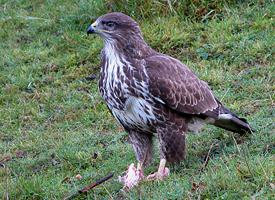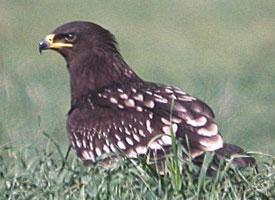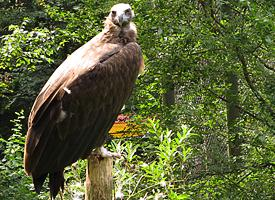
Poids et mesures
| Longueur | de 50 à 57 cm |
|---|---|
| Poids | de 113 à 128 g |
| Envergure des ailes | de 113 à 128 cm |
Description de l'animal
The Common Buzzard (Buteo buteo) is a medium-to-large bird of prey that is widely distributed across Europe and parts of Asia. This raptor is known for its remarkable adaptability, thriving in various habitats including woodlands, farmland, moors, and even suburban areas, making it one of the most common and widespread birds of prey in its range.Physical Characteristics:
The Common Buzzard is a robust bird, with a broad wingspan ranging from 109 to 136 cm, which aids in its soaring and gliding flight. Adult buzzards typically weigh between 427 to 1,364 grams, with females being slightly larger and heavier than males. They possess a rounded head and a somewhat short, hooked beak designed for tearing flesh. Their plumage varies considerably, from light to dark brown, often with a mottled or barred appearance, and a paler underside. The tail, which is relatively short and fan-shaped, usually exhibits bands of different shades. Juveniles tend to have a more streaked appearance compared to adults.
Behavior and Diet:
The Common Buzzard is a versatile predator, with a diet that primarily consists of small mammals, such as voles, rabbits, and mice. It also feeds on birds, insects, earthworms, and carrion. Its hunting technique is quite varied; it may soar high in the sky, using its keen vision to spot prey before swooping down, or it may perch silently in a tree or on a post, waiting to ambush unsuspecting prey.
Reproduction:
Breeding season for the Common Buzzard begins in early spring. Buzzards are monogamous and often mate for life. They build their nests in trees, using twigs and lining them with softer materials. The female usually lays between 2 to 4 eggs, which are incubated for about 33 to 38 days. Both parents are involved in rearing the young, which fledge approximately 50 to 55 days after hatching. The juveniles may remain dependent on their parents for a few weeks before dispersing to establish their own territories.
Migration and Conservation Status:
While some northern populations of Common Buzzards are migratory, moving southwards during the winter, many are resident throughout the year in their breeding territories. The species has shown remarkable resilience and has adapted well to human-altered landscapes, leading to stable or even increasing populations in many areas. As of the last assessment, the Common Buzzard is listed as Least Concern by the IUCN Red List, indicating it is not currently at significant risk of extinction.
In summary, the Common Buzzard is a fascinating and adaptable bird of prey, with a broad range across Europe and parts of Asia. Its success can be attributed to its versatile diet, adaptable hunting strategies, and tolerance of various habitats, including those influenced by human activity.
Carte de répartition
Animaux similaires
Nouvelles photos d'animaux
Top 10 des animaux
- Dolphin gull (Leucophaeus scoresbii)
- Diana monkey (Cercopithecus diana)
- Moustached guenon (Cercopithecus cephus)
- Galápagos tortoise (Geochelone nigra complex)
- Russian tortoise (Testudo horsfieldii)
- Japanese macaque (Macaca fuscata)
- Stone loach (Barbatula barbatula)
- Greek tortoise (Testudo graeca)
- Common flying dragon (Draco volans)
- Colossal squid (Mesonychoteuthis hamiltoni)


